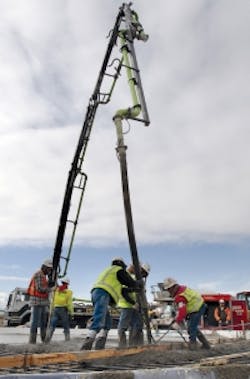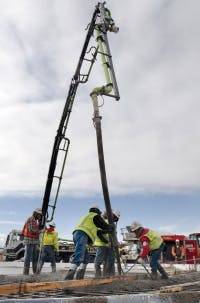Fast Track: Design-Build Delivery Helps Plant Project Meet Tight Schedule
By Nathan Zaugg and Larry Fickel
In an effort to increase production and meet the demands of its western markets, The Dannon Co. (Dannon) engaged MWH to develop its new multi-million dollar wastewater pretreatment system in West Jordan, Utah. The new facility was designed to pre-treat the plant’s wastewater prior to discharge to the local municipality’s system and enable Dannon to double yogurt production.
An accelerated design-build (DB) project delivery method allowed Dannon to begin using its new facility after just six months of design and construction. Accelerated completion of the wastewater pretreatment system was a necessary step in realizing growth for Dannon from a series of other projects happening simultaneously at the plant.
Background
Dannon, a leader in the production of cultured fresh dairy products, has recently experienced a significant growth in sales with the success of its Activia® and other lines of yogurt products. The increase in consumer demand has dictated an increased need in supply, leading the company to expand its West Jordan production facility in August 2010; however, simply expanding the existing wastewater treatment system wasn’t an option as the company faced several issues:
- Yogurt production creates high-strength wastewater and Dannon’s West Jordan treatment facility was already near full capacity.
- Municipal wastewater officials wanted Dannon to include wastewater pretreatment expansion as part of its plans.
- Preliminary engineering showed the existing wastewater facility wouldn’t be ideal to expand since it was in a location better suited for accommodating future plant build-outs.
Given these factors, Dannon determined that constructing a new wastewater facility would be the most effective pretreatment solution because it would allow for future expansion.
The challenge: The new wastewater treatment facility and increased yogurt production capacity would need to go on-line at the same time. Since yogurt production and packaging equipment have a long procurement schedule, equipment was ordered prior to initiating the wastewater design project. This meant the wastewater project had a strict and pre-established completion deadline. In fact, the wastewater facility needed to be designed and constructed in just six months.
Design-Build
Due to this firm deadline and tight schedule, Dannon determined it needed an accelerated DB delivery method to ensure that the wastewater project would be completed to meet the pre-established timeline for start up of yogurt production and packaging facilities. Dannon selected MWH Constructors to design and construct the wastewater pretreatment facility due to the firm’s DB wastewater industry experience, as well as the close working relationship between its engineers and contractors.
With the designer, the construction project manager and the owner working closely together. The team was able to develop innovative solutions and address constructability issues quickly.
According to a study conducted by the Water Design-Build Council, entitled “Independent Comparative Evaluation of Design-Build v. Conventional Design-Bid-Build Project Delivery for Municipal Water and Wastewater Facilities,” the DB delivery method for water and wastewater projects enables them to come in ahead of or on schedule more often than traditional methods and be delivered at or below the owner’s budget almost twice as often with no significant difference in quality.
Prior to starting the construction contract work in late August 2010, MWH completed preliminary engineering of the wastewater pretreatment facility, including the sizing and layout of treatment units. Additionally, the MWH team identified the right DB components to expedite the design, construction and operations of the pretreatment facility.
Treatment Process
The primary treatment process selected was moving bed bioreactor (MBBR) combined with dissolved air flotation (DAF), which includes the pretreatment facility, odor control facilities, pumping, tanks, treatment and storage. The MBBR process was selected because it reduces the volume of biological reactor basins required as compared to conventional treatment systems. By using plastic biological carriers, MBBR systems increase the total biological component of the reactor, which is also helpful when dealing with high strength wastewater, such as that produced by yogurt manufacturing. Overall, the system requires less space than other biological systems and fewer controls, while meeting discharge requirements and handling a flow of several hundred thousand gallons per day. Dannon was the first plant in Utah to use MBBR.
Project Challenges
Project challenges naturally arose, many of which threatened to derail the established DB timeline. The first challenge was permitting, which tends to be a long process under normal circumstances, let alone under a tight timeframe. In addition, the DB process was new to some city officials and there wasn’t any other pretreatment facility of the planned size and scope in West Jordan. MWH worked closely with city officials, obtaining permits on a provisional basis, as the design work became available. Construction started on Nov. 1, 2010, following approval of an amended site plan, conditional use permit and land disturbance permit. All remaining permits were obtained within 45 days of commencement of work.
Winter weather conditions were also a major obstacle. Just after construction started, temperatures at the site plunged to daytime highs of 5°F, and snowfall was a concern. Accordingly, the DB plan called for completing the foundations and building shells as quickly as possible to provide a space that could be heated. This also facilitated timely construction of the electrical and mechanical systems required for the project.
The plan also addressed environmental aspects of the facility, since it was located close to a drinking water well. MWH protected the water source with enhanced stormwater containment and berms around the site.
Startup
The project required startup by March 15, 2011. Thanks to an accelerated DB delivery method, the pretreatment facility began receiving water one day before that deadline on March 14. In the short time available, three steel tanks, a 6,500-sq.-ft. building, two DAFs and air supply system (blowers and diffusers with required stainless steel piping) were completed.
“Without close cooperation of the design and construction teams, completion of the project on this tight timeline wouldn’t have been possible,” said Joshua Besser, Technical Utility and Projects Manager for The Dannon Co. in West Jordan. “We estimate that we saved six months on the construction timeline by using the design-build process, which was critical to meeting our production demands today while allowing us to plan for further expansion in the future.”
About the Authors: Nathan Zaugg, P.E. ([email protected]) is a Wastewater Project Manager for MWH, where he focuses on the design of water and wastewater facilities. Larry Fickel ([email protected]) is a Senior Project Manager for MWH Constructors, where he manages the construction of large water and wastewater facilities.


